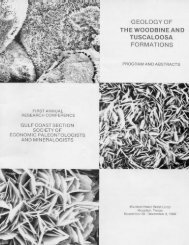Petroleum Systems of Deep-Water Basins - Gulf Coast Section SEPM
Petroleum Systems of Deep-Water Basins - Gulf Coast Section SEPM
Petroleum Systems of Deep-Water Basins - Gulf Coast Section SEPM
Create successful ePaper yourself
Turn your PDF publications into a flip-book with our unique Google optimized e-Paper software.
Regional Mapping and Maturity Modeling for the<br />
Northern <strong>Deep</strong> <strong>Water</strong> <strong>Gulf</strong> <strong>of</strong> Mexico<br />
Edwin L. Colling, Jr.<br />
Texaco Inc.<br />
4800 Fournace Place<br />
Bellaire, Texas 77401-2324<br />
Robert J. Alexander<br />
Texaco Inc.<br />
4800 Fournace Place<br />
Bellaire, Texas 77401-2324<br />
Ronald L. Phair<br />
Texaco Inc.<br />
4800 Fournace Place<br />
Bellaire, Texas 77401-2324<br />
Abstract<br />
Regional mapping and maturity modeling show distinct patterns that are characteristic <strong>of</strong> the complex petroleum<br />
system in the deep water portion <strong>of</strong> the northern <strong>Gulf</strong> <strong>of</strong> Mexico (GOM). Maturity for source rocks within the Cretaceous<br />
and Jurassic sections tends to increase from the abyssal plain to the salt canopy province as the overlying<br />
section thickens. One striking exception to this trend is the Cuba fracture zone, which extends southeast from South<br />
Pass to the southern GOM. Observed as a strong magnetic anomaly in basement maps, the Cuba fracture zone shows<br />
other impressive anomalies. Heat flows tend to increase approximately 25% along the zone relative to calibration<br />
points on either side, which suggests that it is an important crustal feature. Empirically, the Cuba fracture zone<br />
appears to be a major dividing point in the north central GOM, where on its northeast side gas appears to be much<br />
more prominent than on the southwest side.<br />
Mapping the GOM on a regional scale required the integration <strong>of</strong> 2D and 3D seismic data, gravity and magnetic<br />
data, and large-scale velocity models that include salt for proper depth conversion. Basement maps were generated<br />
from the integration <strong>of</strong> gravity and magnetic data with acoustic basement mapping from seismic in the abyssal plain.<br />
A variety <strong>of</strong> key chronostratigraphic horizon depth maps were generated from a regional velocity model that included<br />
salt and was applied to multiple time horizons. Probably the most difficult mapping task was to make accurate correlations<br />
between areas with enormous amounts <strong>of</strong> data (e.g., 3D seismic) and those with a paucity <strong>of</strong> data (e.g., 2D<br />
seismic in subsalt sections). Developing maturity models required an accurate set <strong>of</strong> stratigraphic depth maps, calibration<br />
and mapping <strong>of</strong> heat flow on a large scale, and the appropriate choice <strong>of</strong> source rock horizons and associated<br />
properties to evaluate.<br />
Results from this regional evaluation indicate that there is a definite relationship between source rock maturity<br />
and major oil and gas discoveries. The timing <strong>of</strong> hydrocarbon generation and migration relative to the timing <strong>of</strong> structuring<br />
is critical to each successful discovery. This can be evaluated on a regional scale when maturity results are<br />
placed in context with general structural trends.<br />
5

















